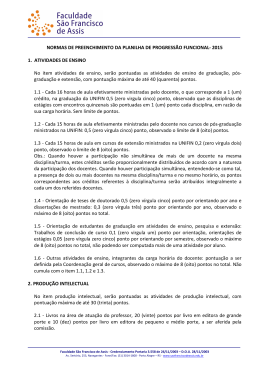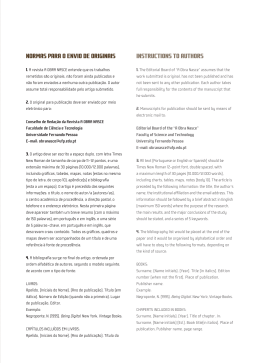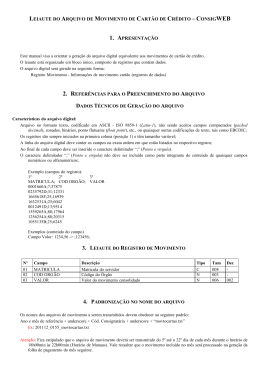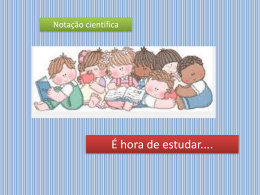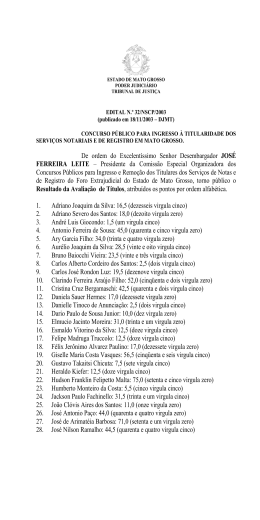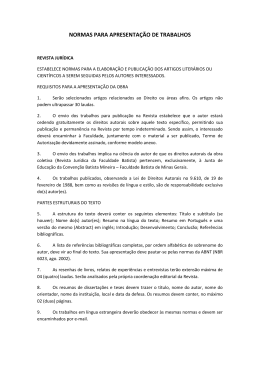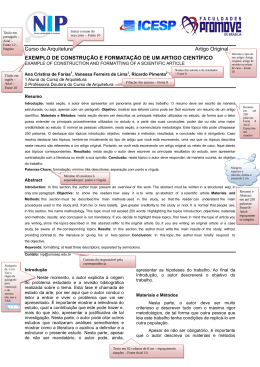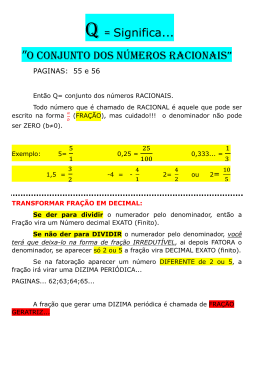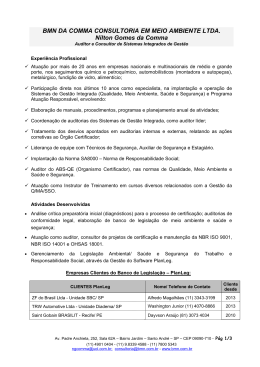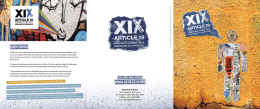Convocatória/chamada para artigos Revista da Faculdade de Letras: CIÊNCIAS E TÉCNICAS DO PATRIMÓNIO vol 14 | 2015 Número temático: Relações de Cooperação Cultural no Noroeste Peninsular Foi há 80 anos que a Universidade do Porto e a cidade acolheram uma multidisciplinar embaixada cultural da Galiza. Com a intervenção de Ramón Otero Pedrayo começava a Semana Cultural Galega no Porto, de 1935. No ano seguinte, deveriam ser os intelectuais e artistas do norte de Portugal a deslocar-se À Galiza, mas a Guerra Civil Espanhola (1936-1939) não o permitiu. O Departamento de Ciências e Técnicas do Património celebra a efeméride convocando a comunidade FLUP e demais interessados para a submissão de artigos destinados ao vol. 14 da revista Ciências e Técnicas do Património, número temático dedicado às relações de cooperação cultural no Noroeste Peninsular. In english: see below. Submissão de artigos: Máximo de 15 páginas de texto + 6 páginas de imagem (a publicar em p/b) Data limite 30 de Setembro de 2015 Enviar para [email protected] / [email protected] / [email protected] Normas para apresentação de propostas de artigos: 1. Os autores devem ter propriedade dos direitos autorais do texto e das imagens, cedendo-os à revista para sua publicação, pois os conteúdos serão disponibilizados em sistema de open access. 2. O texto deve ser redigido em páginas de formato A4, a espaço e meio, com letra Times New Roman, de corpo 12 (para o texto) e de corpo 10 (para as notas de pé-de-página). No caso de compreender catálogo de 1 materiais, este deve ser redigido em letra Times New Roman, corpo 10, com espaçamento de 1 linha. 3. Os textos deverão ser apresentados indicando o título, em letras capitais e a bold (Times New Roman, corpo 14), e o(s) autor(es), indicando-se depois de cada nome, e em linha autónoma, a filiação institucional. O título será centrado. Os autores e sua filiação institucional serão paginados à direita. 4. A abrir o artigo deverá ser apresentado um resumo em português (“Resumo”), acompanhado de palavras-chave (“Palavras-chave”), e um resumo em inglês (“Abstract”) e de palavras-chaves (“Keywords”). Os resumos poderão ter uma extensão máxima de dez linhas. As palavraschave poderão ser quatro. 5. Os textos compreenderão notas de pé-de-página, que deverão ser utilizadas com parcimónia, reservando-se sobretudo para a indicação de referências bibliográficas. Deverão ser evitadas notas demasiado extensas. A indicação das notas, numérica, deve ser preferencialmente colocada depois da última palavra da frase, sem espaço, e antes do ponto final. 6. As citações bibliográficas, em nota de pé-de-página, deverão obedecer à norma anglo-saxónica (AUTOR data: p. ---). 7. A Bibliografia, incluída no final do artigo, obedecerá às seguintes normas: a) Artigo em revista: <APELIDO em maiúscula> <virgula> <Nome Próprio> <espaço> <(ano de edição entre parêntesis)> <virgula> <Título do artigo> <virgula> <nome da revista em itálico> <virgula> <série> <virgula> <volume> <espaço> <(fascículo ou número indicado entre parêntesis)> <virgula> <Local de edição> <virgula> <editora> <virgula> <páginas designadas pp.> Ex.: ALARCÃO, Jorge de (2008), Notas de arqueologia, epigrafia e toponímia – V, Revista Portuguesa de Arqueologia , 11 (1), Lisboa, IGESPAR, pp. 103-121. b) Artigo em obra colectiva: 2 <APELIDO em maiúsculas> <virgula> <Nome Próprio> <espaço> <(ano de edição entre parêntesis)> <virgula> <Título do artigo> <virgula> <In> <espaço> <APELIDO do Coordenador> <virgula> <Nome próprio do Coordenador> <espaço> <(Coord. de) ou (Dir. de)> <virgula> <Título da obra em itálico> <virgula> <volume> <virgula> <Local de edição> <virgula> <editora> <virgula> <páginas designadas pp.> Ex.: TORRES, Cláudio; MACIAS, Santiago (1996), Rituais funerários paleocristãos e islâmicos nas necrópoles de Mértola, in MATTOSO, José (Dir. de), O Reino dos Mortos na Idade Média Peninsular , Lisboa, Edições João Sá da Costa, pp. 11-44. c) Livro: <APELIDO em maiúsculas> <virgula> <Nome Próprio> <espaço> <(ano de edição entre parêntesis)> <virgula> < Título do livro> <virgula> <volume> <virgula> <local de edição> <virgula> <editora>. Nota: Nos livros, o ano indicado reporta-se à edição utilizada. No caso de haver mais do que uma edição pode indicar-se, no fim, entre parêntesis, o local e ano da 1ª edição. Se a obra pertencer a uma colecção, isso poderá ser referido igualmente no final, entre parêntesis. Ex.: JORGE, Susana Oliveira (1999), Domesticar a Terra. As primeiras comunidades agrárias em território português, Lisboa, Gradiva (Col. «Trajectos Portugueses», 45). 8. Qualquer texto com mais de três autores será citado, ao longo do artigo, pelo APELIDO do primeiro autor, Nome Próprio, seguido da expressão " et alii” ou e outros. Na Bibliografia devem aparecer todos os autores. 9. A Bibliografia compreenderá apenas as obras citadas ao longo do artigo, organizadas por ordem alfabética do apelido e nome próprio, e, dentro destes, por ordem cronológica. No caso de haver mais do que uma obra do mesmo autor e ano a distinção será feita pela justaposição de letras (a, b, c...) ao ano de edição. 3 10.As citações de texto deverão abrir e fechar com aspas. Citações em língua estrangeira ou textos com grafias antigas serão apresentados em itálico. 11.Ao longo do texto utilizar-se-á o negrito ou bold apenas para os títulos e subtítulos. Os primeiros serão grafados em maiúsculas, os segundos em corpo normal e, se for o caso, utilizando numeração árabe. 12.As imagens serão posteriormente integradas no texto, tanto quanto possível no local indicado pelo autor, mas deverão ser enviadas em dossier à parte, digitalizadas em alta definição (300 dpi), em ficheiros de formato JPEG ou TIF. 13.Todas as ilustrações (desenhos, fotografias, gráficos, tabelas, diagramas, etcª) serão designadas por «Fig.». Na pasta correspondente aos ficheiros de imagens deverá figurar um documento em word com as legendas das figuras, a fim de serem compostas. 14.Os originais devem ter designações que permitam uma rápida e clara identificação. Juntamente com os originais deve ser fornecido o contacto do autor (ou, no caso de artigo colectivo, do primeiro autor): morada, código postal, telefone e email. 15.A direcção da revista não se responsabiliza pela devolução dos originais. 16.Em fase de revisão de provas não são permitidas alterações de conteúdo. Apenas se aceitam correcções de gralhas. Estas deverão ser assinaladas na margem das provas, a vermelho e de maneira clara e inequívoca. 4 Call for papers Journal of the Faculty of Arts and Humanities of University of Porto: HERITAGE STUDIES | Vol. 14 | 2015 Special Issue: Cultural cooperation relations in the Peninsular Northwest. It was 80 years ago that the University of Porto and the city welcomed a multidisciplinary cultural embassy from Galicia. With the intervention of Ramón Otero Pedrayo it began the Galician Cultural Week in Porto, 1935. The next year should be the intellectuals and artists from northern Portugal to travel At Galicia, but the Spanish Civil War (1936-1939) did not allow it. The Department Heritage Studies celebrates the anniversary summoning the academic community and other interested researchers for submitting articles for the vol. 14 of the Journal of Sciences and Technical Heritage, thematic issue devoted to the cultural cooperation relations in the Peninsular Northwest. Norms for paper submission: Maximum of 15 pages of text + 6 pages of images (to be published on b&w); Deadline: September 30, 2015 Please send the article to [email protected] / [email protected] / [email protected] Norms for publication: 1. The authors must have copyright ownership of text and images, giving them to the journal for publication, as the contents will be made available in open access system. 2. The text must be written in A4 pages, a space and a half, with Times New Roman, body 12 (for text) and size 10 (for foot-de-page notes). In the case of including catalog materials or appendices, this must be written in Times New Roman, size 10, with 1 line spacing. 5 3. The texts must be submitted quoting the title, in capital letters and bold (Times New Roman, size 14), and its author (s), indicating after each name, with separate line, the institutional affiliation. The title must be centered. The authors and their institutional affiliation will be paged on the right. 4. Opening the article should be an abstract in Portuguese («Sumário»), followed by keywords («Palavras-chave»), and an abstract in English and keywords. Abstracts must be no longer than ten lines. The keywords can reach up to four. 5. All texts may comprise foot-de-page notes, to be used parsimoniously, reserving especially for displaying bibliographical references. Too extensive notes should be avoided. The statement notes, numeric, should preferably be placed after the last word of the sentence, with no space, and before the end point. 6. Bibliographic references, standing-de-page note, should follow the Anglo-Saxon norm (AUTHOR date: p ---). 7. The bibliographic references included at the end of the article, must comply the following standards: a. Journal Article: <LAST NAME capitalized> <comma> <First Name> <space> <(year of publication in brackets)> <comma> <title Article> <comma> <name of the magazine in italics> <comma> <number> <comma > <volume> <space> <(issue or number in brackets> <comma> <Place of publication> <comma> <publisher> <comma> < designated pages pp.>. Ex.: ALARCÃO, Jorge de (2008), Notas de arqueologia, epigrafia e toponímia – V, Revista Portuguesa de Arqueologia, 11 (1), Lisboa, IGESPAR, pp. 103-121. b. Article in collective work: <SURNAME in capitals> <comma> <First Name> <space> <(year of publication in brackets)> <comma> <Article title> <comma> <In> <space> <LAST NAME Coordinator> <comma> <Coordinator name> <space> <(Coord. of) or (Dir. of> <comma> <title in italic> <comma> <volume> 6 <comma> <Place of publication> <comma> <publisher > <comma> < designated pages pp.>. Ex.: TORRES, Cláudio; MACIAS, Santiago (1996), Rituais funerários paleocristãos e islâmicos nas necrópoles de Mértola, in MATTOSO, José (Dir. de), O Reino dos Mortos na Idade Média Peninsular, Lisboa, Edições João Sá da Costa, pp. 11-44. c. Books: <SURNAME in capitals> <comma> <First Name> <space> <(year of publication in brackets)> <comma> <Book title> <comma> <volume> <comma> <place of publication> <comma> <publisher>. Note: In the books, the year indicated refers to the edition used. In case there is more than one edition can be stated in the end in brackets, the place and year of the 1st edition. If the work belongs to a collection, that may be also referred to in the end brackets. Ex.: JORGE, Susana Oliveira (1999), Domesticar a Terra. As primeiras comunidades agrárias em território português, Lisboa, Gradiva (Col. «Trajectos Portugueses», 45). 8. Any text with more than three authors will be quoted throughout the article, the first author's name, first name, followed by the latin expression «et al» or and others». In the bibliographic references all authors should be referred. 9. Bibliographic references include only the works cited throughout the article, arranged alphabetically by surname, first name, and within these in chronological order In case there is more than one work by the same author and year the distinction will be made by the juxtaposition of letters (a, b, c ...) to the year of edition. 7 10.The text quotes should open and close with quotes (« »). Quotations in a foreign language or texts with old spellings must be presented in italics. 11.Throughout the text will be used bold or bold only for titles and subtitles. The first case will be graphed on the average body the following ones in normal text and, if necessary, using Arabic numerals. 12.The images will then be integrated into the text as much as possible at the location indicated by the author, but must be submitted in a folder aside, scanned at high resolution (300 dpi), in JPEG or TIF files. 13.All illustrations (drawings, photographs, graphics, etc.) will be referred to as "Fig". In the corresponding folder for image files must appear a document in text or Word with the figure legends, to be composed by the designer. 14.The original paper file must have designations to enable a quick and clear identification Along with the original paper must be provided the author of contact (or in the case of collective article, the first author: address, postcode, telephone and email. 15.The journal’s direction is not responsible for the return of the originals. 16.When reviewing the article scientific content changes are not allowed. We only accept minor corrections. These should be highlighted in the margin of the article, on red ink clearly identified. 8
Download
